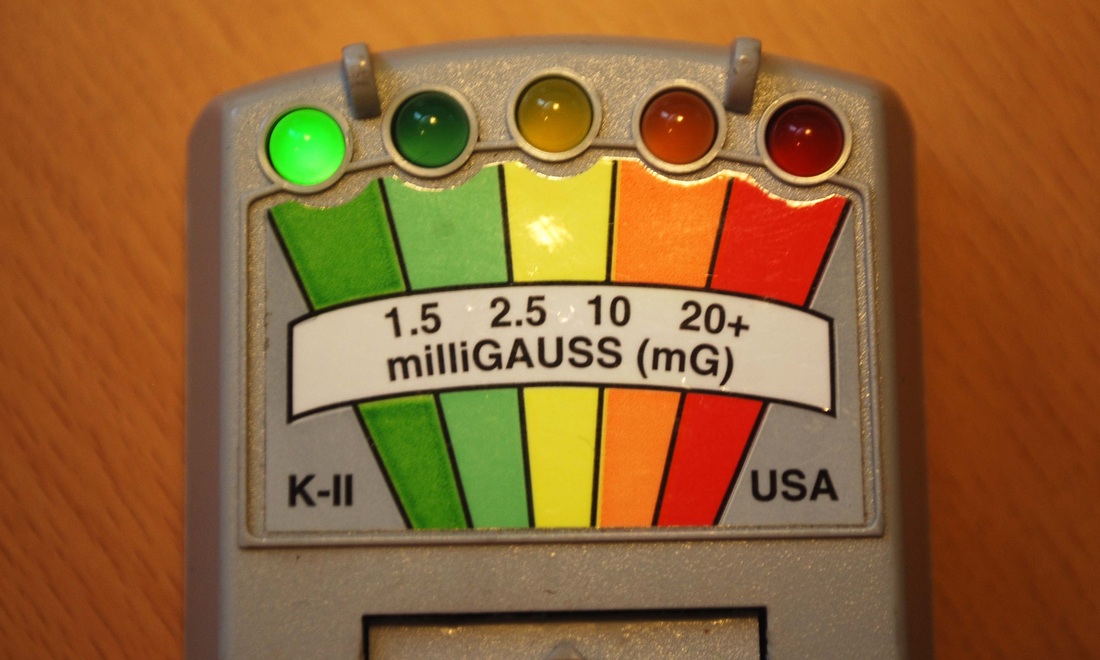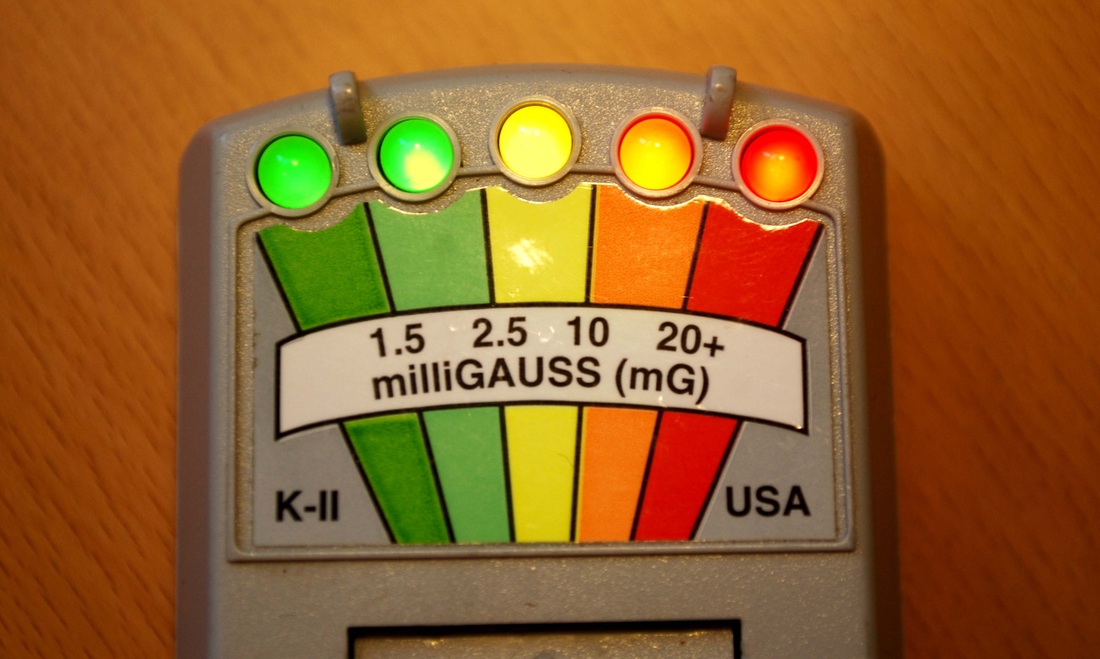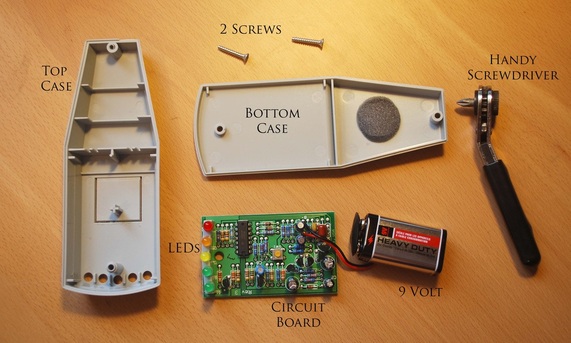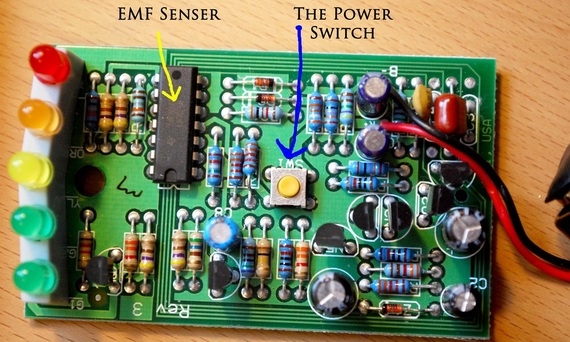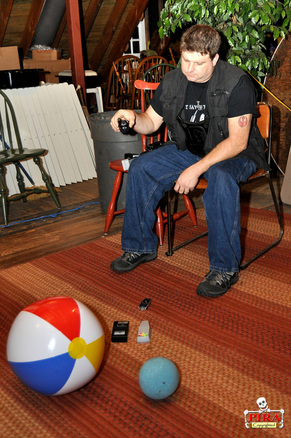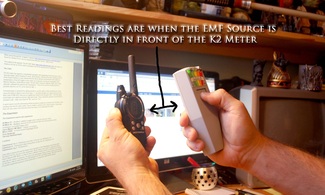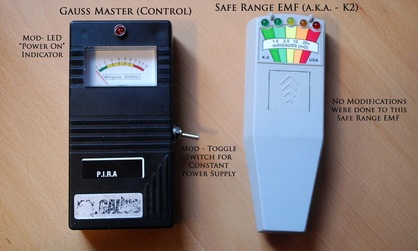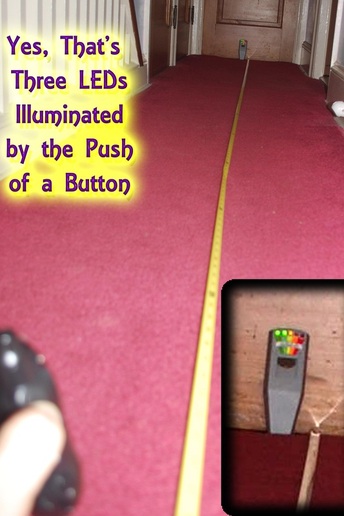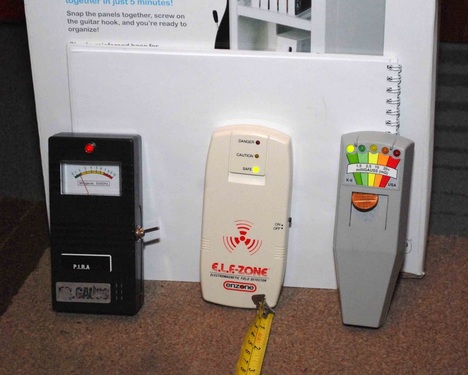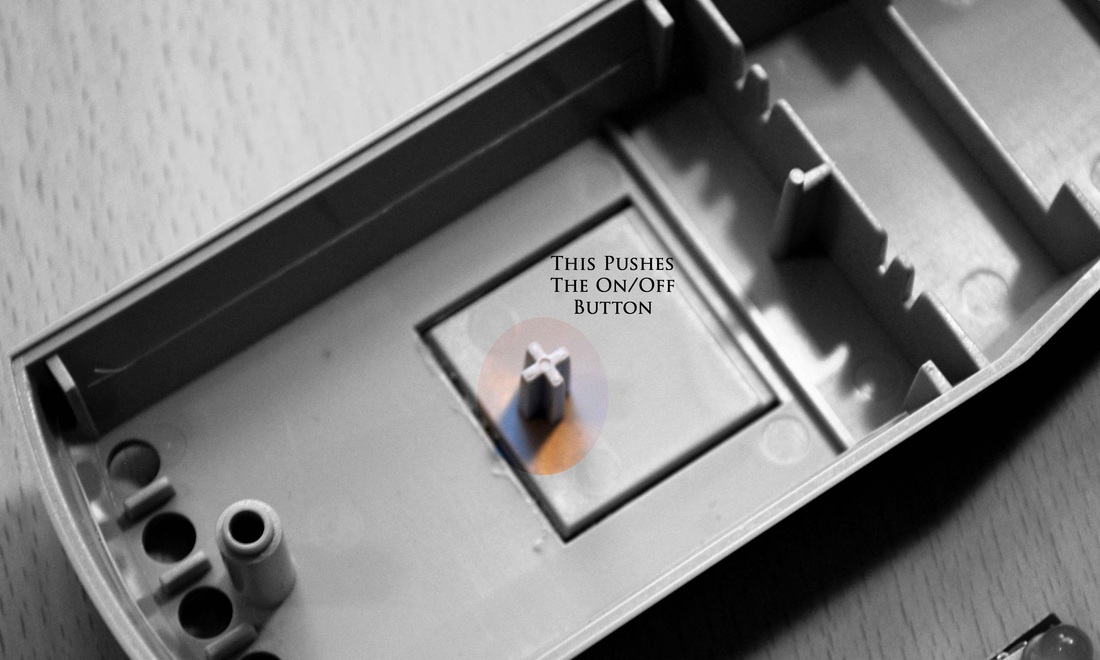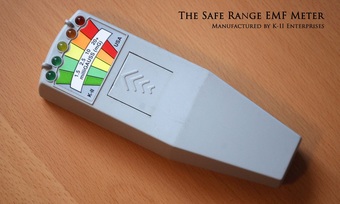
by Kenny Biddle
Direct experiments reveal how easy it is to manipulate one of the most popular “ghost hunting” devices and reveal that basic understanding of this gadget is clearly out of the range of "sciencey" ghost hunters.
A simple hand-held device has become a standard paranormal investigation tool and cultural phenomenon - the now-famous “K2 Meter”. Since its debut on a popular paranormal show, the K-II (K2) EMF Meter has become a must-have device in every ghost hunter’s equipment box. It’s hard to find a team or television series that isn’t using the K2 Meter, many times as their main source of “ghost detection”.
By observing this device in person, on TV, and over a few hundred YouTube videos, some interesting observations can be made. The most obvious is that no one is using the device as it was originally designed - as an electromagnetic field meter.
The sole purpose for which many investigators and ghost hunters purchase an Electromagnetic Field Detector is to help them locate ghosts. Furthermore, the reason the majority of these ghost hunters specifically purchase a K2 meter is because they believe the device allows for communicate with alleged spirits. Obviously, an EMF detector does neither of these, nor was it ever designed for these purposes.
Direct experiments reveal how easy it is to manipulate one of the most popular “ghost hunting” devices and reveal that basic understanding of this gadget is clearly out of the range of "sciencey" ghost hunters.
A simple hand-held device has become a standard paranormal investigation tool and cultural phenomenon - the now-famous “K2 Meter”. Since its debut on a popular paranormal show, the K-II (K2) EMF Meter has become a must-have device in every ghost hunter’s equipment box. It’s hard to find a team or television series that isn’t using the K2 Meter, many times as their main source of “ghost detection”.
By observing this device in person, on TV, and over a few hundred YouTube videos, some interesting observations can be made. The most obvious is that no one is using the device as it was originally designed - as an electromagnetic field meter.
The sole purpose for which many investigators and ghost hunters purchase an Electromagnetic Field Detector is to help them locate ghosts. Furthermore, the reason the majority of these ghost hunters specifically purchase a K2 meter is because they believe the device allows for communicate with alleged spirits. Obviously, an EMF detector does neither of these, nor was it ever designed for these purposes.
The purpose of any electromagnetic field meter is to locate sources of electromagnetic radiation (magnetic, electric and/or RF/microwave) and provide a reading of the relative strength (and direction, if you are a skilled and competent operator) of the EM field.
An Overview of the K-II Meter
The K-II meter, also known as the “Safe Range EMF”, is a simple, single-axis electromagnetic field meter. The device is enclosed within a hard plastic case and is powered by a single a 9-volt battery. A pressure-sensitive switch on the front turns the device on, using your thumb to maintain pressure (a quick hack is to slide a coin between the switch and case). There are modified versions available that have added a toggle switch, allowing power to stay on without the need to constantly hold the button down.
Five LED lights constitute the display that divides the meter’s measurements (in milligauss) into five levels; 1 green = less than 1.5 mG, 2 green = 1.5 mG to 2.5 mG, 3 yellow = 2.5 mG to 10 mG, 4 red = 10 mG to 20 mG, 5 red = over 20 mG. Once power is switched on, the device performs a Self-Test - it flashes the LED lights in succession, from the first to the last (green to red), then back down to the first green LED. It does this twice, and it does it quick (important to remember later on).
An Overview of the K-II Meter
The K-II meter, also known as the “Safe Range EMF”, is a simple, single-axis electromagnetic field meter. The device is enclosed within a hard plastic case and is powered by a single a 9-volt battery. A pressure-sensitive switch on the front turns the device on, using your thumb to maintain pressure (a quick hack is to slide a coin between the switch and case). There are modified versions available that have added a toggle switch, allowing power to stay on without the need to constantly hold the button down.
Five LED lights constitute the display that divides the meter’s measurements (in milligauss) into five levels; 1 green = less than 1.5 mG, 2 green = 1.5 mG to 2.5 mG, 3 yellow = 2.5 mG to 10 mG, 4 red = 10 mG to 20 mG, 5 red = over 20 mG. Once power is switched on, the device performs a Self-Test - it flashes the LED lights in succession, from the first to the last (green to red), then back down to the first green LED. It does this twice, and it does it quick (important to remember later on).
The device operates on a 50 and 60 Hz level. It can detect Extremely Low Frequencies (50 to 1,000 Hz) & Very Low Frequency range (1,000 to 20,000 Hz). I should note that some retailers of this device advertise that it operates as low as 30 Hz [1]. A common misconception among paranormal enthusiasts is that when they employ these devices, they are measuring “the” electromagnetic spectrum – meaning the entire electromagnetic spectrum. The fact is, they are only measuring a small portion of the spectrum. The KII only covers the ELF and about 1/8 of the radio waves potion of the spectrum – a small fraction of the entire spectrum.
The response time of the K2 is almost instantaneous. As a “single- axis” meter, it only reads one axis, left to right (it does not read the other two axes). This means that the meter itself needs to be rotated on all three axes (X, Y and Z) in order to obtain the most accurate reading. From my own tests, the device best reads fields directly in front of it - holding the device so the LEDs are facing you and an EMF source is on the opposite side of the device.
Once you open the device up and take a peek inside, its simplicity is revealed. There isn’t much to it - a circuit board and battery. The device is produced by a company named K-II Enterprises, which also produces three other devices The company also produces three other devices; The Dazer II® (an ultrasonic dog deterrent), the Pet-Agree® (Ultrasonic pet trainer), and the Tattle Tale® (A vibration alarm for training pets and security).
The response time of the K2 is almost instantaneous. As a “single- axis” meter, it only reads one axis, left to right (it does not read the other two axes). This means that the meter itself needs to be rotated on all three axes (X, Y and Z) in order to obtain the most accurate reading. From my own tests, the device best reads fields directly in front of it - holding the device so the LEDs are facing you and an EMF source is on the opposite side of the device.
Once you open the device up and take a peek inside, its simplicity is revealed. There isn’t much to it - a circuit board and battery. The device is produced by a company named K-II Enterprises, which also produces three other devices The company also produces three other devices; The Dazer II® (an ultrasonic dog deterrent), the Pet-Agree® (Ultrasonic pet trainer), and the Tattle Tale® (A vibration alarm for training pets and security).
The device weighs in at 3.8 oz., and measures 5.5 inches long, 2 inches wide and 1 inch in depth. While going through the company's website. I found no mention of its use as a paranormal detection device what-so-ever. It sells for $59.99 [2]
The Claim
The K2 meter gained its considerable reputation after appearing in the third season of the ghost hunting TV show, Ghost Hunters. It was claimed that the device allowed communication from spirits by manipulation of the LED lights on the meter. In an episode covering an investigation of the Manson Murders, Grant Wilson states:
“The K2 meter measures magnetic fields, and it’s been specially calibrated for paranormal investigators”.
I have yet to uncover exactly how this device could possibly be “specially calibrated” for paranormal investigators (but he’s on TV, so he must be right...right?). The statement is not only false, it’s absurd.
Alleged communication with the other side is achieved by asking various questions, and the spirits (or other entity) would answer by causing the LEDs to flash in one of two ways - up in rapid succession to the third, forth, or fifth LED, then just as rapidly back down… or all of the LEDs lit up in rapid succession, then back down - twice. Ghost hunters asking questions of the spirits would enforce a standard code – flash the lights once flash for “No”, and twice for “Yes”.
The internet contains a plethora of websites and videos showing how the K2 meter works, how to modify it, and examples of individuals showing how (they believe) it detects spirit entities. There are also just as many videos and websites that demonstrate how easy it is to manipulate the meter thus producing the desired results of ghost enthusiasts everywhere. The most notable of these manipulations is finding the “sweet spot” on the power switch – applying just enough pressure on the switch so that it appears to be fully depressed, but the switch is making the slightest contact. This allows the operator to manipulate the device, causing the LEDs to dance crazily and/or flash twice on a consistent basis (remember the self-test?).
On the website ‘The KII EMF Meter’, it states “The K-II EMF meter is the perfect partner that you want to bring on all of your paranormal investigations to ensure the highest chance of capturing paranormal activity.” [1] Despite this bold claim, there has never been, nor is there still any scientifically valid evidence to support such a claim.
The Experiments
With the popularity of these devices on paranormal-themed shows and with ghost hunting teams (and even with Bigfoot hunters now), I decided to perform some simple experiments to see how the device faired against a little critical review. Regardless of what the TV folks report these devices can do (detect/communicate with spirits), no one had tested the devices under conditions found during a “ghost hunt”. I wanted to see what else, besides alleged ghosts, would cause these devices to light up.
I had been invited to participate in a public ghost hunt at the Sun Inn, located in Bethlehem, Pennsylvania by a local paranormal group. This was a good opportunity to see a group use the device, as well as to observe how they reacted with other standard equipment used. The first four experiments were performed during this ghost hunt. The remaining six were conducted in my office.
I used a Gauss Master meter to compare the sensitivity of the Safe Range meter (K2). Two K2 meters were used in the first of these experiments, in conjunction with a Gauss Master EMF Meter. All three meters were placed on the floor, with no more than three feet between them. Once the devices were in place, they were not handled whatsoever (no human contact). A steady measurement of just under 2 mG was observed which we used as our baseline (verified by the Gauss Master).
The equipment used for experiments 1 to 4:
Experiments 5 to 9:
Experiment 10:
Experiment 1 - Powering on a Video Camera Test
An unexpected test occurred as one of the investigators turned on a Sony Handycam video camera to record an “EVP session”. At a distance of approximately seven feet from K2 Meter #1 and the Gauss Master, the K2 registered a spike to the 3rd LED (2.5 mG to 10 mG), while the Gauss Master momentarily increased to just over 2 mG. Repeating the power cycle of the video camera two additional times repeated the results.
Experiment 2 - Energizing a Slave Flash Test
Using a Nikon D5000 with a Nikon Speedlight SB- 600 shoe-mounted flash, we waited for the flash to go into “stand by” mode. The shutter release was given a half-press to “wake up” the flash unit. The moment the flash powered up, K2 meter #2 registered a spike to the 3rd LED (2.5 mG to 10 mG). K2 meter #1 registered a spike to the 2nd LED (1.5 mG to 2.5 mG).
However, on a second attempt, none of the meters registered any type of spike or fluctuation. On a third consecutive attempt, a spike to the 3rd light was recorded again. I determined that this issue was most likely due to the initial charging of the flash when coming out of sleep mode. Our second attempt had been done immediately after the flash unit was already charged. By allowing the flash unit to go into Stand By again, the spike on the meters registered again.
Experiment 3 - Two-way Radio
A two-way radio was positioned approximately 3 to 4 feet away from K2 Meter #1 and the Gauss Master, and 5 to 6 feet from K2 Meter #2. The “Talk” button on a two-way radio was quickly depressed and released once. Both K2 meters illuminated up to the 3rd LED (2.5 mG to 10 mG), but the Gauss Master meter did not register any change from the Base Reading. The “Talk” button was depressed several more times, with the LED display flashing up to the 3rd or 4th LED with each depression of the two-way radio Talk button.
To test relative distance to position, the two-way radio was moved to a distance of approximately ten (10) feet from K2 #1 and the Gauss Master, at four different positions (with the K2 meter centered on the floor, the two-way radio was placed forward of the meter, to the rear of the meter, to the right, and then above the meter). The “Talk” button was depressed several times. From these four positions, the meter registered the highest readings when positioned to the right of the meter with the antenna (of the two-way radio) pointed towards the meter.
The Claim
The K2 meter gained its considerable reputation after appearing in the third season of the ghost hunting TV show, Ghost Hunters. It was claimed that the device allowed communication from spirits by manipulation of the LED lights on the meter. In an episode covering an investigation of the Manson Murders, Grant Wilson states:
“The K2 meter measures magnetic fields, and it’s been specially calibrated for paranormal investigators”.
I have yet to uncover exactly how this device could possibly be “specially calibrated” for paranormal investigators (but he’s on TV, so he must be right...right?). The statement is not only false, it’s absurd.
Alleged communication with the other side is achieved by asking various questions, and the spirits (or other entity) would answer by causing the LEDs to flash in one of two ways - up in rapid succession to the third, forth, or fifth LED, then just as rapidly back down… or all of the LEDs lit up in rapid succession, then back down - twice. Ghost hunters asking questions of the spirits would enforce a standard code – flash the lights once flash for “No”, and twice for “Yes”.
The internet contains a plethora of websites and videos showing how the K2 meter works, how to modify it, and examples of individuals showing how (they believe) it detects spirit entities. There are also just as many videos and websites that demonstrate how easy it is to manipulate the meter thus producing the desired results of ghost enthusiasts everywhere. The most notable of these manipulations is finding the “sweet spot” on the power switch – applying just enough pressure on the switch so that it appears to be fully depressed, but the switch is making the slightest contact. This allows the operator to manipulate the device, causing the LEDs to dance crazily and/or flash twice on a consistent basis (remember the self-test?).
On the website ‘The KII EMF Meter’, it states “The K-II EMF meter is the perfect partner that you want to bring on all of your paranormal investigations to ensure the highest chance of capturing paranormal activity.” [1] Despite this bold claim, there has never been, nor is there still any scientifically valid evidence to support such a claim.
The Experiments
With the popularity of these devices on paranormal-themed shows and with ghost hunting teams (and even with Bigfoot hunters now), I decided to perform some simple experiments to see how the device faired against a little critical review. Regardless of what the TV folks report these devices can do (detect/communicate with spirits), no one had tested the devices under conditions found during a “ghost hunt”. I wanted to see what else, besides alleged ghosts, would cause these devices to light up.
I had been invited to participate in a public ghost hunt at the Sun Inn, located in Bethlehem, Pennsylvania by a local paranormal group. This was a good opportunity to see a group use the device, as well as to observe how they reacted with other standard equipment used. The first four experiments were performed during this ghost hunt. The remaining six were conducted in my office.
I used a Gauss Master meter to compare the sensitivity of the Safe Range meter (K2). Two K2 meters were used in the first of these experiments, in conjunction with a Gauss Master EMF Meter. All three meters were placed on the floor, with no more than three feet between them. Once the devices were in place, they were not handled whatsoever (no human contact). A steady measurement of just under 2 mG was observed which we used as our baseline (verified by the Gauss Master).
The equipment used for experiments 1 to 4:
- K2 Meter #1 - Modified, installed a toggle switch under the pressure switch
- K2 Meter #2 - Modified, removed circuit and placed within new housing (black plastic, rectangular) and added toggle switch.
- Gauss Master EMF Meter - Original, un-modified
- Nikon D5000 - w/ shoe-mounted Speedlight SB-600 Sony Handycam
- Cobra MicroTalk PR4500 GMRS/FRS - 16 Mile Two-Way Radio
Experiments 5 to 9:
- K2 Meter - Original, Unmodified unit
- Gauss Master EMF Meter - Modified with Power Toggle switch, and an additional LED Power On indicator.
- Motorola Two-Way Radio - Model k7gt9500
- Blackberry Storm - from Verizon Wireless
- Microsoft Wireless Intellimouse Explorer
- Motorola T-9500 - Two-way Handheld Radio
Experiment 10:
- K2 Meter - Original, Unmodified unit
- Gauss Master EMF Meter - Modified with Power Toggle switch, and additional LED Power On indicator.
- Motorola Two-Way Radio - Model k7gt9500
- E.L.F.-Zone Meter - Unmodified unit, produced by Enzone, Production Date 1994
Experiment 1 - Powering on a Video Camera Test
An unexpected test occurred as one of the investigators turned on a Sony Handycam video camera to record an “EVP session”. At a distance of approximately seven feet from K2 Meter #1 and the Gauss Master, the K2 registered a spike to the 3rd LED (2.5 mG to 10 mG), while the Gauss Master momentarily increased to just over 2 mG. Repeating the power cycle of the video camera two additional times repeated the results.
Experiment 2 - Energizing a Slave Flash Test
Using a Nikon D5000 with a Nikon Speedlight SB- 600 shoe-mounted flash, we waited for the flash to go into “stand by” mode. The shutter release was given a half-press to “wake up” the flash unit. The moment the flash powered up, K2 meter #2 registered a spike to the 3rd LED (2.5 mG to 10 mG). K2 meter #1 registered a spike to the 2nd LED (1.5 mG to 2.5 mG).
However, on a second attempt, none of the meters registered any type of spike or fluctuation. On a third consecutive attempt, a spike to the 3rd light was recorded again. I determined that this issue was most likely due to the initial charging of the flash when coming out of sleep mode. Our second attempt had been done immediately after the flash unit was already charged. By allowing the flash unit to go into Stand By again, the spike on the meters registered again.
Experiment 3 - Two-way Radio
A two-way radio was positioned approximately 3 to 4 feet away from K2 Meter #1 and the Gauss Master, and 5 to 6 feet from K2 Meter #2. The “Talk” button on a two-way radio was quickly depressed and released once. Both K2 meters illuminated up to the 3rd LED (2.5 mG to 10 mG), but the Gauss Master meter did not register any change from the Base Reading. The “Talk” button was depressed several more times, with the LED display flashing up to the 3rd or 4th LED with each depression of the two-way radio Talk button.
To test relative distance to position, the two-way radio was moved to a distance of approximately ten (10) feet from K2 #1 and the Gauss Master, at four different positions (with the K2 meter centered on the floor, the two-way radio was placed forward of the meter, to the rear of the meter, to the right, and then above the meter). The “Talk” button was depressed several times. From these four positions, the meter registered the highest readings when positioned to the right of the meter with the antenna (of the two-way radio) pointed towards the meter.
Experiment 4 - EVP Session Test
The group proceeded with an EVP session (electronic voice phenomena) in which they would attempt to communicate with a ghost. This was a good time for me to test the spirit communication claim. During this experiment, we agreed to bypass the standard “two spikes = yes, one spike = no” criteria. This was to avoid any confusion between a possible “hit” (manipulation of the device by an unknown entity) and the normal operation of the Self-Test that the device does (which causes it to automatically flash twice).
To make this test as basic as possible, I looked for any noticeable manipulation of the device by outside sources. All the equipment, including cell phones and the other EMF meters, were removed from the area while this session was in progress. While the device was active, the group leader spoke out loud: “If there are any spirits here, please answer our questions by causing the device to illuminate”.
Questions:
1 - “If there is anyone here besides myself, Mike and Scott...could you cause the device to illuminate?
2 - “You can, in theory, cause the lights to light up simply by moving close to this device. Would you move to stand next to the device?”
3 - “Can you try to pick up the device?”
4 - “Can you please touch the device?”
5 - “Would you sit it this chair?” (Chair was positioned next to the K2 meter)
6 - “If you need to Say “Yes”, try to make the device flash its lights twice. Can you do that?”
7 - “Can you jump on the device?”
8 - “Can you try to push the device off the table?”
9 - “Is there anything you can do to manipulate the device to illuminate it?”
10 - “Last chance, make the device light up or we’re through with you.”
After this series of questions, we allowed the K2 Meter to stay on during the rest of the investigation session. At no time did the meter register any fluctuations.
Experiment 5 - Two-Way Radio, Hand in Hand with K2 Test
This experiment reproduces a common scenario using the meter seen on the various TV shows - holding the K2 meter in one hand, and having a conversation with a two-way radio in the other hand. This is the worst way to use this device, yet I’ve seen it dozens of times.
In some cases, the investigator places the meter down on the floor, bed, or table and sits a few feet away (sometimes on the bed with the device), asking questions. Then they begin filling in the other team members of what’s going on using the radio.
Any ghost hunter within 25 feet of the K2 Meter who has a two-way radio can possibly render any readings. In close proximity to each other, the radio causes the LED lights on the K2 meter to flash extremely rapidly. With some practice, I was able to cause the K2 LEDs to dance in various patterns by manipulating the “Call” button on the two-way radio. The results of this test were consistent in each attempt to manipulate the device.
Experiment 6 - Two-Way Radio at Three to Five feet
In Experiment 5, we held the meter only 16 to 20 inches away from the two-way radio. This distance simulated the average distance an investigator would be holding the meter in one hand while speaking into the tow-way radio with the other. In Experiment 6, we simulated the situations where a ghost hunter would place the K2 on a bed or table, and then sits next to it.
This test did not produce identical results with each pressing of the “Call” button on the radio. Sometimes the meter would “spike” into the 5th red LED while other times only caused the first two green LEDs to dimly flutter. This appears to be due to the position of the meter, the position of the radio, and how quickly I pushed the “Call” button in and out. The relative orientation of both devices would cause a higher or lower reading. This fits nicely with many of the videos available that show ghost hunters repositioning the meter several times during a session in order to get the best “connection” (most effective orientation) to the “spirits”.
It was during this experiment that I noticed that my body itself was increasing the reading. While holding the two-way radio out at arm’s length, I began manipulating the CALL button while holding in the power switch of the K2. After achieving several spikes, I jammed a dime into the pressure switch on the K2 (which effectively holds the switch down), put it down, and held the radio out at arm’s length again. This time, the meter only lit up three LEDs. I questioned whether my body was causing the previous, higher reading. I put my hand on the K2 and activated the radio and the reading was much stronger. By removing and replacing my hand on the K2 Meter, higher levels were consistently registered on the K2 meter.
The group proceeded with an EVP session (electronic voice phenomena) in which they would attempt to communicate with a ghost. This was a good time for me to test the spirit communication claim. During this experiment, we agreed to bypass the standard “two spikes = yes, one spike = no” criteria. This was to avoid any confusion between a possible “hit” (manipulation of the device by an unknown entity) and the normal operation of the Self-Test that the device does (which causes it to automatically flash twice).
To make this test as basic as possible, I looked for any noticeable manipulation of the device by outside sources. All the equipment, including cell phones and the other EMF meters, were removed from the area while this session was in progress. While the device was active, the group leader spoke out loud: “If there are any spirits here, please answer our questions by causing the device to illuminate”.
Questions:
1 - “If there is anyone here besides myself, Mike and Scott...could you cause the device to illuminate?
2 - “You can, in theory, cause the lights to light up simply by moving close to this device. Would you move to stand next to the device?”
3 - “Can you try to pick up the device?”
4 - “Can you please touch the device?”
5 - “Would you sit it this chair?” (Chair was positioned next to the K2 meter)
6 - “If you need to Say “Yes”, try to make the device flash its lights twice. Can you do that?”
7 - “Can you jump on the device?”
8 - “Can you try to push the device off the table?”
9 - “Is there anything you can do to manipulate the device to illuminate it?”
10 - “Last chance, make the device light up or we’re through with you.”
After this series of questions, we allowed the K2 Meter to stay on during the rest of the investigation session. At no time did the meter register any fluctuations.
Experiment 5 - Two-Way Radio, Hand in Hand with K2 Test
This experiment reproduces a common scenario using the meter seen on the various TV shows - holding the K2 meter in one hand, and having a conversation with a two-way radio in the other hand. This is the worst way to use this device, yet I’ve seen it dozens of times.
In some cases, the investigator places the meter down on the floor, bed, or table and sits a few feet away (sometimes on the bed with the device), asking questions. Then they begin filling in the other team members of what’s going on using the radio.
Any ghost hunter within 25 feet of the K2 Meter who has a two-way radio can possibly render any readings. In close proximity to each other, the radio causes the LED lights on the K2 meter to flash extremely rapidly. With some practice, I was able to cause the K2 LEDs to dance in various patterns by manipulating the “Call” button on the two-way radio. The results of this test were consistent in each attempt to manipulate the device.
Experiment 6 - Two-Way Radio at Three to Five feet
In Experiment 5, we held the meter only 16 to 20 inches away from the two-way radio. This distance simulated the average distance an investigator would be holding the meter in one hand while speaking into the tow-way radio with the other. In Experiment 6, we simulated the situations where a ghost hunter would place the K2 on a bed or table, and then sits next to it.
This test did not produce identical results with each pressing of the “Call” button on the radio. Sometimes the meter would “spike” into the 5th red LED while other times only caused the first two green LEDs to dimly flutter. This appears to be due to the position of the meter, the position of the radio, and how quickly I pushed the “Call” button in and out. The relative orientation of both devices would cause a higher or lower reading. This fits nicely with many of the videos available that show ghost hunters repositioning the meter several times during a session in order to get the best “connection” (most effective orientation) to the “spirits”.
It was during this experiment that I noticed that my body itself was increasing the reading. While holding the two-way radio out at arm’s length, I began manipulating the CALL button while holding in the power switch of the K2. After achieving several spikes, I jammed a dime into the pressure switch on the K2 (which effectively holds the switch down), put it down, and held the radio out at arm’s length again. This time, the meter only lit up three LEDs. I questioned whether my body was causing the previous, higher reading. I put my hand on the K2 and activated the radio and the reading was much stronger. By removing and replacing my hand on the K2 Meter, higher levels were consistently registered on the K2 meter.
| Experiment 7 - Two-Way Radio Distance Test This experiment was performed in the second floor hallway of my home. I set up the K2 Meter against a door (standing up, with LEDs facing me). With a two-way radio in hand, I tested several distances while attempting to manipulate the meter. The radio was set to Channel 1, and I began pressing the “Call” button several times, turning the radio in different directions. Depending on the position I held the two-way radio, I was able to get a consistent spike of three LEDs each time the “Call” was pressed, and also when the button was released. This consistency decreased with distance. At fifteen feet from the target (K2 meter), I was still able to get two LEDs to illuminate. At sixteen feet, I could no longer manipulate the meter. Experiment 8 - Call on a Cell Phone Test I had received reports from several friends noting that the K2 will register a “Hit” when they receive or transmit a call on their cell phones. Many of today’s “smart” phones are constantly sending updating signals to the cell tower, generating a pulse. I tried several functions on a Blackberry Storm device to see if any effect it had on the K2. Sometimes the meter would pick up Facebook notification update from about 5 inches away, sometimes it wouldn’t. I made 63 calls to my house and 64 calls from my house to the cell phone. Making or receiving the call caused the same result. At a distance of 7-10 inches, the call would cause a K2 spike. It is a very natural position to hold the meter about 10 inches from a phone worn on the belt which can easily lead to false readings. Some paranormal teams require you to silence your cell phone during investigations. However, if you receive a call while “scanning” for EMF anomalies, you may not realize it was your phone that actually set off the meter – not a ghost. |
Experiment 9 - Computer Mouse Test
As I was working on this article, I observed another simple trigger of the device. I had set the meter down on my desk, and began manipulating the computer mouse. I noticed that as I moved the wireless mouse, three to four lights would flash on the K2 display. The meter was about six inches from the mouse at the time, so I move the meter to 26 inches away. I was still getting a reading on the meter each time I manipulated the mouse. The strength of the EM field reading was depended on the orientation of the meter itself, and I found that I could still get a reading up to three feet away.
Experiment 10 - Three Meters with Two-Way Radio
For the final experiment, I acquired an E.L.F.-Zone Electromagnetic Field Detector from ENZONE. Using three different EMF meters, I set them all up in a row against a cardboard box. I pressed the “talk” button on the two-way radio in order to observe the response of the meters at various distances.
As I was working on this article, I observed another simple trigger of the device. I had set the meter down on my desk, and began manipulating the computer mouse. I noticed that as I moved the wireless mouse, three to four lights would flash on the K2 display. The meter was about six inches from the mouse at the time, so I move the meter to 26 inches away. I was still getting a reading on the meter each time I manipulated the mouse. The strength of the EM field reading was depended on the orientation of the meter itself, and I found that I could still get a reading up to three feet away.
Experiment 10 - Three Meters with Two-Way Radio
For the final experiment, I acquired an E.L.F.-Zone Electromagnetic Field Detector from ENZONE. Using three different EMF meters, I set them all up in a row against a cardboard box. I pressed the “talk” button on the two-way radio in order to observe the response of the meters at various distances.
At a distance of up to 5 feet, the K2 Meter would rapidly and continuously flash four LED lights as long as I held the “talk” button if the radio faced the meters. With the back of the radio towards the meters, there was a weak pulsing of the 2nd LED light on the K2.
When the two-way radio was waved around in a quick motion, the K2 meter would flash up to all five LED lights from a distance of approximately 12 feet, with field strength signals dependent on how the direction and angle of the radio.
Although the meter was unpredictable at times, it was consistently easy to manipulate.
When the two-way radio was waved around in a quick motion, the K2 meter would flash up to all five LED lights from a distance of approximately 12 feet, with field strength signals dependent on how the direction and angle of the radio.
Although the meter was unpredictable at times, it was consistently easy to manipulate.
| Discussion These simple tests show several reasons why the K2 device should NOT be used during any investigation into the paranormal. The first concern is the power switch. With a little practice, it was very simple to locate the “sweet” spot where the button will go between on/off without the operator seeing or hearing the entire switch come to the “at rest” position (power off). Because the device’s self-test causes all five LEDs to light up twice, and when power is interrupted the first LED will go out… we can look back at the early use of the device on popular TV shows and see that it was most likely related to this cause, rather than any “spirit communication”. |
This particular “trick” eventually became common knowledge to most ghost hunters. The two-way radio “trick” was also discovered by many ghost hunters to cause the K2 meter to light up like a Christmas tree. Ghost hunters that were overenthusiastic could be anywhere in the room, or more importantly, off-camera, and cause the LEDs on the meter to dance around.
However, the idea that the K2 meter has consistently “proved” communication with spirits became a well-established belief among many paranormal enthusiasts. There are scores of “sciencey” based teams that still make this extraordinary claim, yet never provide valid supporting evidence.
The K2 device has shown to be much more sensitive than other EMF meters found on the market. I found an interesting note from the GhostMart website in response to their own testing with various devices. They stated: “When used side by side with these high end digital models one thing became very clear. The readings produced by the K-II were simply not consistent. It was in fact very responsive to EMF fluctuations but there was no pattern to the level of the EMF measured by the K-II Meter.” [3]
My testing confirmed the same. We must also take into account the various other devices used in and around an uncontrolled environment on an investigation - audio recorders, motion sensors, ghost boxes (modified radios), refrigerators, alarm systems, etc. These devices will have varying EM fields depending on start-up sequences, on/off cycling, and consistency of power usage, etc.
Every video segment that has been presented as “proof” of spirit communication can easily be duplicated by manipulations of the common two-way radio, even from someone in another room. Considering that so many ghost hunting teams use two-way radios as standard equipment, it’s easy to see how false readings and outright fraud can occur quite easily.
The K-II device was not designed or manufactured for use in paranormal investigation. It was designed to read a small part of the electromagnetic field from household devices and give a general measurement of strength. Adding a toggle switch does not make it “modified for paranormal research”. Endorsements from para-celebrities do not validate this device as a legitimate paranormal tool. The Safe Range EMF meter performs as it was intended to perform, nothing more and nothing supernatural.
There is no evidence to back up the claim that ghosts (however you may define them) have any effect on the electromagnetic field, or that any EMF meter has the ability to detect or be manipulated by a ghost.
Millions of viewers tune into to the various ghost hunter shows each week. Too many wishful paranormal enthusiasts easily accept a concept and device simply because they saw it on a TV show – a show designed for entertainment purposes only. Groups are buying the K2 Meter, and other equally worthless paranormal devices, because their favorite para-personalities are using them.
This article shows how simple, direct experiments reveal how easy it is to manipulate one of the most popular “ghost hunting” devices. Although I didn’t carefully cover every possible scenario, I believe the point has been made. It’s a waste of money and effort, and gives you worthless data for baseless conclusions.
References
1. The KII EMF meter http://www.kiimeter.com/
2. KII Enterprises http://www.kiienterprises.com/index.html
3. GhostMart.com http://www.ghost-mart.com/
All photographs credit Kenneth Biddle and used with permission.
However, the idea that the K2 meter has consistently “proved” communication with spirits became a well-established belief among many paranormal enthusiasts. There are scores of “sciencey” based teams that still make this extraordinary claim, yet never provide valid supporting evidence.
The K2 device has shown to be much more sensitive than other EMF meters found on the market. I found an interesting note from the GhostMart website in response to their own testing with various devices. They stated: “When used side by side with these high end digital models one thing became very clear. The readings produced by the K-II were simply not consistent. It was in fact very responsive to EMF fluctuations but there was no pattern to the level of the EMF measured by the K-II Meter.” [3]
My testing confirmed the same. We must also take into account the various other devices used in and around an uncontrolled environment on an investigation - audio recorders, motion sensors, ghost boxes (modified radios), refrigerators, alarm systems, etc. These devices will have varying EM fields depending on start-up sequences, on/off cycling, and consistency of power usage, etc.
Every video segment that has been presented as “proof” of spirit communication can easily be duplicated by manipulations of the common two-way radio, even from someone in another room. Considering that so many ghost hunting teams use two-way radios as standard equipment, it’s easy to see how false readings and outright fraud can occur quite easily.
The K-II device was not designed or manufactured for use in paranormal investigation. It was designed to read a small part of the electromagnetic field from household devices and give a general measurement of strength. Adding a toggle switch does not make it “modified for paranormal research”. Endorsements from para-celebrities do not validate this device as a legitimate paranormal tool. The Safe Range EMF meter performs as it was intended to perform, nothing more and nothing supernatural.
There is no evidence to back up the claim that ghosts (however you may define them) have any effect on the electromagnetic field, or that any EMF meter has the ability to detect or be manipulated by a ghost.
Millions of viewers tune into to the various ghost hunter shows each week. Too many wishful paranormal enthusiasts easily accept a concept and device simply because they saw it on a TV show – a show designed for entertainment purposes only. Groups are buying the K2 Meter, and other equally worthless paranormal devices, because their favorite para-personalities are using them.
This article shows how simple, direct experiments reveal how easy it is to manipulate one of the most popular “ghost hunting” devices. Although I didn’t carefully cover every possible scenario, I believe the point has been made. It’s a waste of money and effort, and gives you worthless data for baseless conclusions.
References
1. The KII EMF meter http://www.kiimeter.com/
2. KII Enterprises http://www.kiienterprises.com/index.html
3. GhostMart.com http://www.ghost-mart.com/
All photographs credit Kenneth Biddle and used with permission.
Kenny Biddle is a writer, photographer and investigator of paranormal claims. He is a photography consultant for the Mutual UFO Network (MUFON) and gives training and talks on critical thinking and false-positives in paranormal photography. For advice regarding a paranormal claim, contact him through the Anomalies Research Society.

